Compact, high power design contributes to improved performance in high power applications
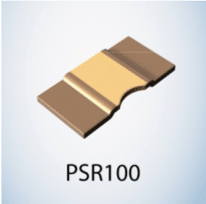 ROHM has recently announced the development of a more compact version of its highly regarded PSR series of high power ultra-low-ohmic shunt resistors for current detection in automotive and industrial applications.
ROHM has recently announced the development of a more compact version of its highly regarded PSR series of high power ultra-low-ohmic shunt resistors for current detection in automotive and industrial applications.
Shunt resistors are widely used in the automotive and industrial markets to detect current in high power sets. In the automotive field, the shift towards computerization and electro-mechanical systems resulting from the need to provide greater safety and efficiency along with the emergence of electric vehicles has increased the number of number of small motors and ECUs required, driving the demand for compact shunt resistors that can support higher power. In response, ROHM has expanded its high power, ultra-low resistance PSR lineup to include even smaller sizes.
The PSR100 series adopts a high performance metal alloy as the resistive element to provide superior temperature coefficient of resistance (TCR). In addition, leveraging original precision welding technology makes it possible to successfully deliver high power (3W) in a compact 6.35×3.05mm form factor – impossible to achieve until now.
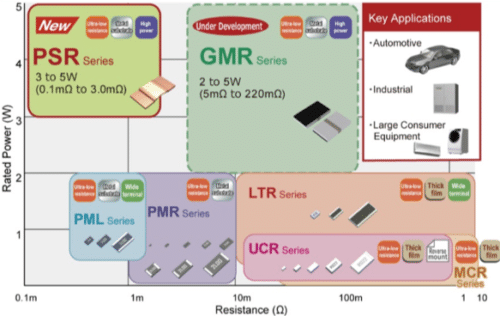
This ensures sufficient margin for use in sets with demanding temperature requirements, such as industrial equipment, reducing design load and contributing to greater end-product miniaturization.
Key Features
1. High rated power in a compact size
 Traditionally, there has been a trade-off relationship between rated power and size, making it difficult to achieve both at the same time. However, proprietary precision welding technology allowed ROHM to create a high heat dissipation structure that fuses small copper plates to a metallic alloy, delivering high power capability (3W) in a compact size (6.34 x 3.05mm). This makes it possible to meet customer needs for both power and size in the automotive, industrial, and other markets with stringent requirements.
Traditionally, there has been a trade-off relationship between rated power and size, making it difficult to achieve both at the same time. However, proprietary precision welding technology allowed ROHM to create a high heat dissipation structure that fuses small copper plates to a metallic alloy, delivering high power capability (3W) in a compact size (6.34 x 3.05mm). This makes it possible to meet customer needs for both power and size in the automotive, industrial, and other markets with stringent requirements.
2. Excellent temperature coefficient of resistance – even in the ultra-low resistance region
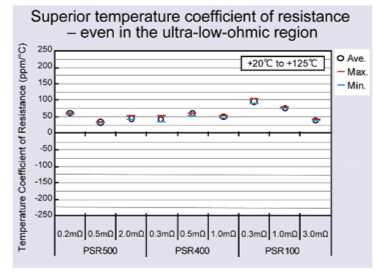 Generally, the lower the resistance the higher the temperature coefficient of resistance (TCR). However, the PSR series utilizes a high performance metallic resistive element that ensures superior TCR, even in the ultra-low-resistance region. This latest lineup is offered in resistances as low as 0.3mΩ, providing greater applicability.
Generally, the lower the resistance the higher the temperature coefficient of resistance (TCR). However, the PSR series utilizes a high performance metallic resistive element that ensures superior TCR, even in the ultra-low-resistance region. This latest lineup is offered in resistances as low as 0.3mΩ, providing greater applicability.
Applications
Automotive: Onboard chargers, electric compressors, EPS
Industrial: UPS, base stations
Circuit Diagram
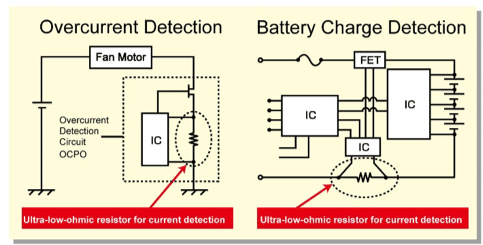
Specifications
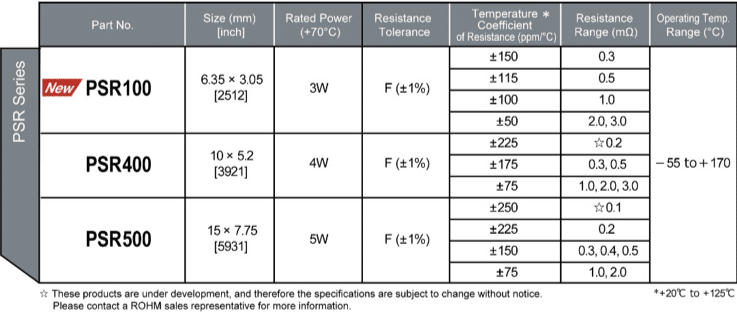
Terminology
TCR (Temperature Coefficient of Resistance)
The lower the value, the less resistance change with a change in ambient temperature. This makes it possible to suppress variations during device operation.







